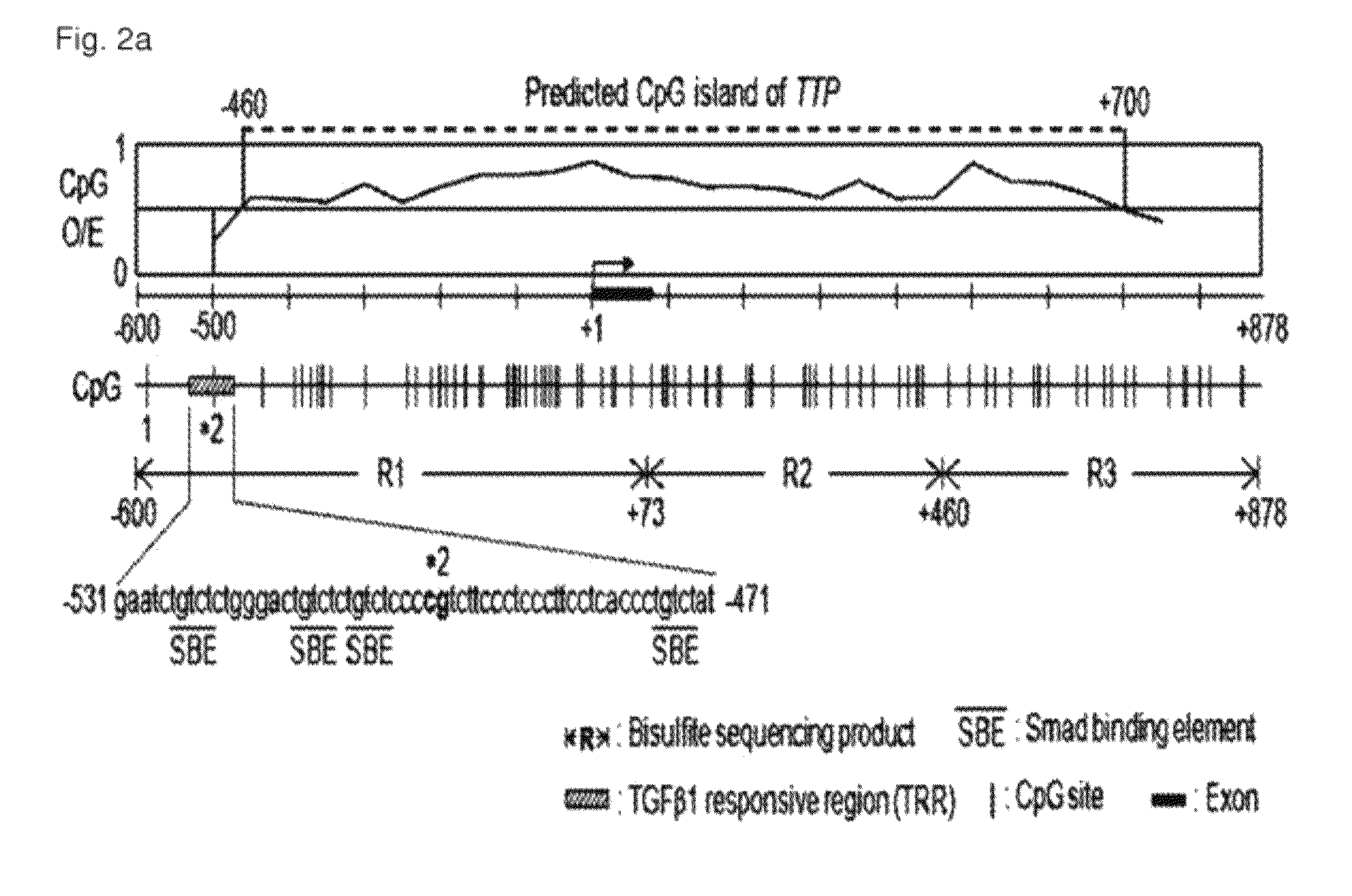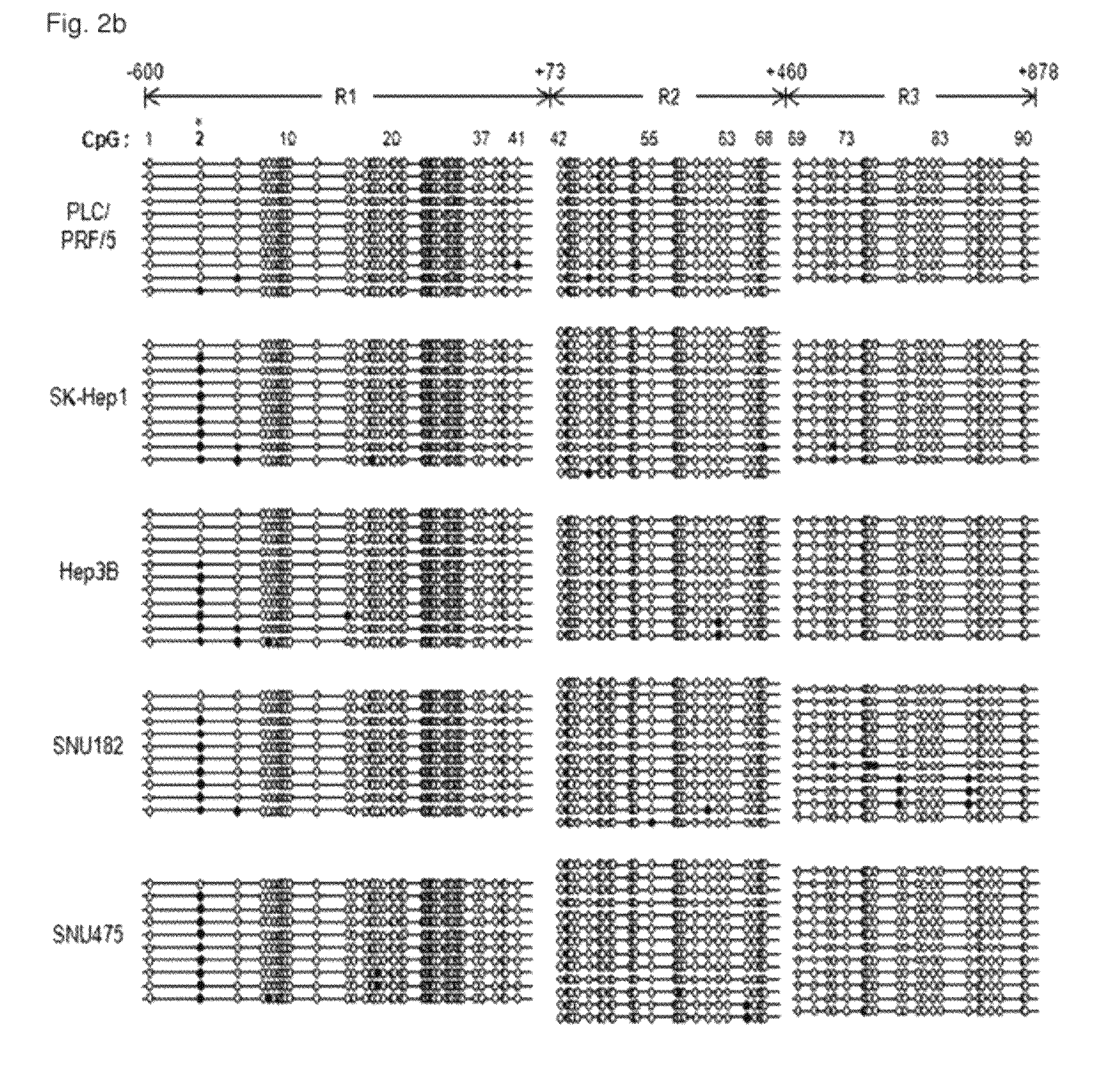Method for diagnosis/prognosis of cancers using an epigenetic marker consisting of a specific single CpG site in TTP promoter and treatment of cancers by regulating its epigenetic status
a technology of epigenetic markers and cancers, applied in the direction of biocide, drug composition, peptide/protein ingredients, etc., can solve the problems that the role of epigenetic markers in cancer development and progression has not been clearly defined to date, and achieve the effect of effective us
- Summary
- Abstract
- Description
- Claims
- Application Information
AI Technical Summary
Benefits of technology
Problems solved by technology
Method used
Image
Examples
example 1
Down-Regulation of TTP (tristetraprolin) via DNA Methylation in HCC Cell Lines
[0104] Culture of HCC Cell Lines
[0105]SK-Hep1, Hep3B, PLC / PRF / 5, HepG2 (ATCC, USA) and HuH-7 (HSRRB, Japan) cell lines were maintained in DMEM (Dulbecco's modified Eagle medium; Invitrogen, USA) supplemented with heat-inactivated 10% fetal bovine serum and penicillin / streptomycin (Invitrogen). SNU cell lines (KCLB, Korea) were maintained as above, except that DMEM was replaced with RPMI1640 (Invitrogen).
[0106] Comparison of TTP mRNA Expression by RT-PCR
[0107]Total RNA was extracted from the HCC cell lines by using RNeasy mini kit (QIAGEN, USA). Distilled water was added to 1 μg of the total RNA and 1 μl of oligo-d(T) (Invitrogen, USA, 0.5 μg / μl) to make the total volume of the mixture 50 μl, followed by RT-PCR in AccuPower RT-premix (Bioneer, Korea). Before RT-PCR, cDNA was synthesized as follows: at 70° C. for 5 minutes, at 4° C. for 5 minutes, at 42° C. for 60 minutes, at 94° C. for 5 minutes, and at 4° ...
example 2
Methylation of Single CpG Site in TTP Promoter in HCC Cells
[0117]As shown in FIG. 2a, for the sequencing of promoter and enhancer regions, positions −600 by to +878 bp from the transcription initiation site of TTP were divided into three regions of R1˜R3, followed by bisulfite sequencing using the primer sets shown in Table 2. That is, all cytosine residues were converted into urasil residues by treating bisulfite and then sequencing was performed. At this time, methylated cytosine was not converted into urasil.
[0118]
TABLE 2Re-gionSense primerAntisense primerR1TGGGATTATAGGTGTGAGTT:AACAATCAAATCCATAATATAAC:SEQ. ID. NO. 5SEQ. ID. NO. 6R2GTTATATTATGGATTTGATTCACCCTAAAACTTCAACCC:GTT: SEQ. ID. NO. 7SEQ. ID. NO. 8R3GTTGAAGTTTTAGGGTGGG:TAAAACACCTAAAAATACAAAASEQ. ID. NO. 9C: SEQ. ID. NO. 10
[0119]As a result, as shown in FIGS. 2b and 2c, 90 CpG sites were confirmed and a single CpG site (#2 CpG) was located in TRR (TGFβ1 responsive region; SEQ. ID. NO. 41) of the TTP promoter at the 5′-boundar...
example 3
#2 CpG Site Methylation in Clinical Samples of HCC
[0120] Clinical Tissue Samples of HCC
[0121]As shown in Table 3, twenty-four surgically resected HCC and corresponding adjacent non-tumor tissue samples were obtained from the surgical pathology files of the Catholic University of Korea the College of Medicine (CUKCM, Korea). HCC samples were diagnosed using the Edmondson-Steiner grading system. All sampling was approved by the Institutional Review Board of CUKCM, and the appropriate consent obtained. Normal human liver genomic DNA (BioChain) and normal human liver total RNA (Clontech, USA) were purchased as controls.
[0122]
TABLE 3Edmondson -TTP mRNA ex-#2 CpGTissueFibrosisSteinerpression cmethylationd (%)No.AgeGendergradeagradeVirusbNontumorTumorNontumorTumor169M4IB1.360.232.645.90.070.01249M4IIB1.020.174.132.60.080.01357M4IVB0.310.2331.439.80.060.05458F4IIN1.500.333.839.70.100.04570M4IVC0.730.3519.933.20.040.03629F4IB1.080.194.046.90.090.02758M2IVB0.320.0721.629.30.040.01853M4IIN0.95...
PUM
| Property | Measurement | Unit |
|---|---|---|
| total volume | aaaaa | aaaaa |
| time | aaaaa | aaaaa |
| length | aaaaa | aaaaa |
Abstract
Description
Claims
Application Information
 Login to View More
Login to View More - R&D
- Intellectual Property
- Life Sciences
- Materials
- Tech Scout
- Unparalleled Data Quality
- Higher Quality Content
- 60% Fewer Hallucinations
Browse by: Latest US Patents, China's latest patents, Technical Efficacy Thesaurus, Application Domain, Technology Topic, Popular Technical Reports.
© 2025 PatSnap. All rights reserved.Legal|Privacy policy|Modern Slavery Act Transparency Statement|Sitemap|About US| Contact US: help@patsnap.com



